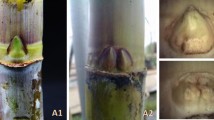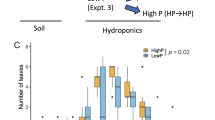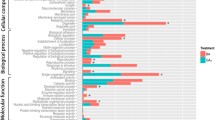Abstract
Branching is an important factor affecting the yield of Brassica napus L. Generally, however, field-grown B. napus cannot develop branches from the middle and lower parts of the plant, although axillary buds are present in these parts. To explore the cause of this phenomenon at the mRNA level, we analyzed buds from the top, upper, middle and lower parts of B. napus by RNA-SEq. In total, 27,992 expressed genes were found, 479 of which were considered to be closely related to axillary bud development. Genes related to the regulation of sugar signaling and plant hormone signal transduction were subjected to Gene Ontology (GO) and Kyoto Encyclopedia of Genes and Genomes (KEGG) enrichment analyses. Seven types of transcription factors, including phytochrome-interacting factors (PIFs), homeobox 1 (HB-1), light sensitive hypocotyls 4 (LSH4), BRANCHED 1 (BRC1), WRKY DNA-binding proteins (WRKYs) and Transducin/WD40 repeat-like superfamily proteins (WD40s), were enriched. The soluble sugar content in the axillary buds was assessed and found to differ significantly among the four regions of the plant; in short, the soluble sugar content decreased from top to bottom. In this study, we provide a transcriptional profile of axillary buds from different parts of B. napus plants; these data will be important for future studies on the growth and development of axillary buds.








Similar content being viewed by others
References
Abe H, Yamamoto KT et al (1985) Characterization of green tissue-specific phytochrome isolated immunochemically from pea seedlings. Plant Cell Physiol 26(7):1387–1399
Aguilarmartinez JA, Pozacarrion C et al (2007) Arabidopsis BRANCHED1 acts as an integrator of branching signals within axillary buds. Plant Cell 19(2):458–472
Arite T, Iwata H et al (2007) DWARF10, an RMS1/MAX4/DAD1 ortholog, controls lateral bud outgrowth in rice. Plant J 51(6):1019–1029
Arrom L, Munné-Bosch S (2012) Sucrose accelerates flower opening and delays senescence through a hormonal effect in cut lily flowers. Plant Sci 188–189(3):41–47
Ballare CL, Casal JJ (2000) Light signals perceived by crop and weed plants. Field Crops Res 67(2):149–160
Barbier F, Péron T et al (2015) Sucrose is an early modulator of the key hormonal mechanisms controlling bud outgrowth in Rosa hybrida. J Exp Bot 66(9):2569–2582
Barbier F, Peron T et al (2015) Sucrose is an early modulator of the key hormonal mechanisms controlling bud outgrowth in Rosa hybrida. J Exp Bot 66(9):2569–2582
Beveridge CA, Dun EA et al (2009) Pea has its tendrils in branching discoveries spanning a century from auxin to strigolactones. Plant Physiol 151(3):985–990
Ding G, Zhao Z et al (2012) Quantitative trait loci for seed yield and yield-related traits, and their responses to reduced phosphorus supply in Brassica napus. Ann Bot 109(4):747–759
Campbell DC, Kondra ZP (1978) Relationships among growth patterns, yield components and yield of rap. Can J Plant Sci 58(1):87–93
Chatfield SP, Stirnberg P et al (2000) The hormonal regulation of axillary bud growth in Arabidopsis. Plant J 24(2):159–169
Chen B, Xu K et al (2014) Evaluation of yield and agronomic traits and their genetic variation in 488 global collections of Brassica napus L. Genet Resour Crop Evol 61(5):979–999
Christine A, Elizabeth BD et al (2009) Pea has its tendrils in branching discoveries spanning a century from auxin to strigolactones. Plant Physiol 151(3):985–990
Djennane S, Hibrand-Saint OL et al (2014) Impacts of light and temperature on shoot branching gradient and expression of strigolactone synthesis and signalling genes in rose. Plant Cell Environ 37(3):742–757
Doebley J, Stec AO et al (1997) The evolution of apical dominance in maize. Nature 386(6624):485–488
Eastmond PJ, Van Dijken AJH et al (2010) Trehalose-6-phosphate synthase 1, which catalyses the first step in trehalose synthesis, is essential for Arabidopsis embryo maturation. Plant J 29(2):225–235
Ebell LF (1969) Variation in total soluble sugars of conifer tissues with method of analysis. Phytochemistry 8(1):227–233
Endt DV, Kijne JW et al (2002) Transcription factors controlling plant secondary metabolism: what regulates the regulators? Phytochemistry 61(2):107–114
Evenson RE, Gollin DJ (2003) Assessing the impact of the green revolution, 1960 to 2000. Science 300(5620):758–762
Finlayson SA (2007) Arabidopsis Teosinte Branched1-LIKE 1 regulates axillary bud outgrowth and is homologous to monocot Teosinte Branched1. Plant Cell Physiol 48(5):667–677
Franklin KA (2010) Shade avoidanc. New Phytol 179(4):930–944
Furuya M (1989) Molecular properties and biogenesis of phytochrome I and II. Adv Biophys 25(89):133–167
Gilor K, Rakefet DS et al (2012) The pitfalls of transgenic selection and new roles of AtHXK1: a high level of AtHXK1 expression uncouples hexokinase1-dependent sugar signaling from exogenous sugar. Plant Physiol 159(1):47–51
Girault T, Veronique D, Combes et al (2010) Light controls shoot meristem organogenic activity and leaf primordia growth during bud burst in Rosa sp. Plant Cell Environ 31(11):1534–1544
Gomezroldan V, Fermas S et al (2008) Strigolactone inhibition of shoot branching. Nature 455(7210):189–194
Gonzalezgrandio E, Pozacarrion C et al (2013) BRANCHED1 promotes axillary bud dormancy in response to shade in arabidopsis. Plant Cell 25(3):834–850
Griffith M, Lumb C et al (2005) Antifreeze proteins modify the freezing process planta. Plant Physiol 138(1):330–340
Guo D, Zhang J et al (2015) The WRKY transcription factor WRKY71/EXB1 controls shoot branching by transcriptionally regulating RAX genes in Arabidopsis. Plant Cell 27(11):3112–3127
Hibara K, Karim MR et al (2006) Arabidopsis CUP-SHAPED COTYLEDON3 regulates postembryonic shoot meristem and organ boundary formation. Plant Cell 18(11):2946–2957
James C (2001) Global review of commercialized transgenic crops: 2000. Nutr Newslett 25(4):1–2
Janssen BJ, Drummond RS et al (2014) Regulation of axillary shoot development. Curr Opin Plant Biol 17(17C):28–35
Jeon J, Kim J (2013) Arabidopsis response Regulator1 and Arabidopsis histidine phosphotransfer Protein2 (AHP2), AHP3, and AHP5 function in cold signaling. Plant Physiol 161(1):408–424
Jeon J, Kim NY et al (2010) A subset of cytokinin two-component signaling system plays a role in cold temperature stress response in Arabidopsis. J Biol Chem 285(30):23371–23386
José Antonio A-M, César P-C et al (2007) Arabidopsis BRANCHED1 acts as an integrator of branching signals within axillary buds. Plant Cell 19(2):458–472
Kang NY, Cho C et al (2012) Cytokinin receptor-dependent and receptor-independent pathways in the dehydration response of Arabidopsis thaliana. J Plant Physiol 169(14):1382–1391
Katz A, Oliva M et al (2004) FIE and CURLY LEAF polycomb proteins interact in the regulation of homeobox gene expression during sporophyte development. Plant J 37(5):707–719
Kebrom TH, Burson BL et al (2006) Phytochrome B represses Teosinte Branched1 expression and induces sorghum axillary bud outgrowth in response to light signals. Plant Physiol 140(3):1109–1117
Kebrom TH, Burson BL et al (2006) Phytochrome B represses Teosinte Branched1 expression and induces sorghum axillary bud outgrowth in response to light signals. Plant Physiol 140(3):1109
Khush GS (2001) Green revolution: the way forward. Nat Rev Genet 2(10):815–822
Koch KE (2004) Sucrose metabolism: regulatory mechanisms and pivotal roles in sugar sensing and plant development. Curr Opin Plant Biol 7(3):235–246
Larcher W (2004) Physiological plant ecology. Ecophysiology and stress physiology of functional groups. Plant J 37(5):707–719
Leduc N, Roman H et al (2014) Light signaling in bud outgrowth branching in plants. Plants 3(2):223–250
Leivar P, Monte E et al (2008) The arabidopsis phytochrome-interacting factor PIF7, together with PIF3 and PIF4, regulates responses to prolonged red light by modulating phyB levels. Plant Cell 20(2):337–352
Li Y (1964) Preliminary study on the main stem traits of rapeseed. J Crop Sci 3(4):429–438
Li CJ, Bangerth F (1999) Autoinhibition of indoleacetic acid transport in the shoots of two-branched pea (Pisum sativum) plants and its relationship to correlative dominance. Physiol Plant 106(4):415–420
Li F, Chen B et al (2016) A genome-wide association study of plant height and primary branch number in rapeseed (Brassica napus). Plant Science 242:169–177
Li J, Li G et al (2004) Phytochrome signaling mechanisms. Arabidopsis Book 9(9):157–159
Liu J, Wang W et al (2016) Characterizing variation of branch angle and genome-wide association mapping in rapeseed (Brassica napus L.). Front Plant Sci 7:21–21
Lunn JE, Feil R et al (2006) Sugar-induced increases in trehalose 6-phosphate are correlated with redox activation of ADP glucose pyrophosphorylase and higher rates of starch synthesis in Arabidopsis thaliana. Biochem J 397(1):139–148
Mandel MA, Gustafsonbrown C et al (1992) Molecular characterization of the Arabidopsis floral homeotic gene APETALA1. Nature 360(6401):273–277
Manon M, Marianne A et al (2012) Mutations in the Arabidopsis homolog of LST8/GβL, a partner of the target of Rapamycin kinase, impair plant growth, flowering, and metabolic adaptation to long days. Plant Cell 24(2):463–481
Mao X, Cai T et al (2005) Automated genome annotation and pathway identification using the KEGG Orthology (KO) as a controlled vocabulary. Bioinformatics 21(19):3787–3793
Mason MG, Jha D et al (2010) Type-B response regulators ARR1 and ARR12 regulate expression of AtHKT1;1 and accumulation of sodium in Arabidopsis shoots. Plant J 64(5):753–763
Mcsteen P (2009) Hormonal regulation of branching in grasses. Plant Physiol 149(1):46–55
Meyer RC, Matthias S et al (2007) The metabolic signature related to high plant growth rate in Arabidopsis thaliana. Proc Natl Acad Sci USA 104(11):4759–4764
Meyer RC, Steinfath M et al (2007) The metabolic signature related to high plant growth rate in Arabidopsis thaliana. Proc Natl Acad Sci USA 104(11):4759–4764
Mishra BS, Manjul S et al (2009) Glucose and auxin signaling interaction in controlling Arabidopsis thaliana seedlings root growth and development. PLoS ONE 4(2):e4502
Miyawaki K, Matsumotokitano M et al (2004) Expression of cytokinin biosynthetic isopentenyltransferase genes in Arabidopsis: tissue specificity and regulation by auxin, cytokinin, and nitrate. Plant J 37(1):128–138
Mori H (2001) Control of outgrowth and dormancy in axillary buds. Plant Physiol 127(4):1405–1413
Morris DA (1977) Transport of exogenous auxin in two-branched dwarf pea seedlings (Pisum sativum L.): Some implications for polarity and apical dominance. Planta 136(1):91–96
Muller D, Leyser O (2011) Auxin, cytokinin and the control of shoot branching. Ann Bot 107(7):1203–1212
Nakashima K, Fujita Y et al (2009) Three Arabidopsis SnRK2 Protein Kinases, SRK2D/SnRK2.2, SRK2E/SnRK2.6/OST1 and SRK2I/SnRK2.3, involved in ABA signaling are essential for the control of seed development and dormancy. Plant Cell Physiol 50(7):1345–1363
Nookaew I, Papini M et al (2012) A comprehensive comparison of RNA-Seq-based transcriptome analysis from reads to differential gene expression and cross-comparison with microarrays: a case study in Saccharomyces cerevisiae. Nucleic Acids Res 40(20):10084–10097
Nordstrom A, Tarkowski P et al (2004) Auxin regulation of cytokinin biosynthesis in Arabidopsis thaliana: a factor of potential importance for auxin–cytokinin-regulated development. Proc Natl Acad Sci USA 101(21):8039–8044
Paul MJ, Primavesi LF et al (2008) Trehalose metabolism signaling . Ann Rev Plant Biol 59(1):417–441
Pierik R, Testerink C (2014) The art of being flexible: how to escape from shade Salt Drought. Plant Physiol 166(1):5–22
Qiu D, Morgan C et al (2006) A comparative linkage map of oilseed rape and its use for QTL analysis of seed oil and erucic acid content. Theor Appl Genet 114(1):67–80
Rabot A, Henry C et al (2012) Insight into the Role of sugars in bud burst under light in the rose. Plant Cell Physiol 53(6):1068
Reddy SK, Finlayson SA (2014) Phytochrome B promotes branching in Arabidopsis by suppressing auxin signaling. Plant Physiol 164(3):1542–1550
Reddy SK, Holalu SV et al (2013) Abscisic Acid regulates axillary bud outgrowth responses to the ratio of red to far-red light. Plant Physiol 163(2):1047–1058
Reinhardt D, Kuhlemeier C (2002) Plant architecture. Embo Rep 3(9):846–851
Rolland F, Baenagonzalez E et al (2006) Sugar sensing and signaling in plants: conserved and novel mechanisms. Annu Rev Plant Biol 57(1):675–709
Ruan Y (2014) Sucrose metabolism: gateway to diverse carbon use and sugar signaling. Annu Rev Plant Biol 65(1):33–67
Sakamoto T, Matsuoka M (2004) Generating high-yielding varieties by genetic manipulation of plant architecture. Curr Opin Biotechnol 15(2):144–147
Santosmendoza M, Dubreucq B et al (2008) Deciphering gene regulatory networks that control seed development and maturation in Arabidopsis. Plant J 54(4):608–620
Sarlikioti V, Visser PHBD et al (2011) How plant architecture affects light absorption and photosynthesis in tomato: towards an ideotype for plant architecture using a functional–structural plant model. Ann Bot 108(6):1065
Satohnagasawa N, Nagasawa N et al (2006) A trehalose metabolic enzyme controls inflorescence architecture in maize. Nature 441(7090):227–230
Scott C, Naoki S et al (2010) Strigolactones enhance competition between shoot branches by dampening auxin transport. Development 137(17):2905
Seale M, Bennett T et al (2017) BRC1 expression regulates bud activation potential, but is not necessary or sufficient for bud growth inhibition in Arabidopsis. Development 144(9):1661–1673
Shah S, Karunarathna NL et al (2018) An APETALA1 ortholog affects plant architecture and seed yield component in oilseed rape (Brassica napus L.). BMC Plant Biol 18(1):380
Smith H (2003) Physiological and ecological function within the phytochrome family. Ann Rev Plant Biol 46(1):289–315
Smith H, Whitelam GC (2010) The shade avoidance syndrome: multiple responses mediated by multiple phytochromes. Plant Cell Environ 20(6):840–844
Stirnberg P, Ward S et al (2010) Auxin and strigolactones in shoot branching: intimately connected? Biochem Soc Trans 38(2):717–722
Su YH, Liu YB et al (2011) Auxin–Cytokinin interaction regulates meristem development. Molecular Plant 4(4):616–625
Takano M, Kanegae H et al (2001) Isolation and characterization of rice phytochrome A mutants. Plant Cell 13(3):521–534
Takeda T, Suwa Y et al (2003) The OsTB1 gene negatively regulates lateral branching in rice. Plant J 33(3):513–520
Umehara M, Hanada A et al (2008) Inhibition of shoot branching by new terpenoid plant hormones. Nature 455(7210):195–200
Umezawa T, Sugiyama N et al (2009) Type 2C protein phosphatases directly regulate abscisic acid-activated protein kinases in Arabidopsis. Proc Natl Acad Sci USA 106(41):17588–17593
Wang Y, Li J (2011) Branching in rice. Curr Opin Plant Biol 14(1):94–99
Wang Y, Li J (2008) Molecular basis of plant architecture. Ann Rev Plant Biol 59(1):253–279
Weller JL, Murfet IC et al (1997) Pea mutants with reduced sensitivity to far-red light define an important role for phytochrome a in day-length detection. Plant Physiol 114(4):1225–1236
Wickson M, Thimann KV (1958) The antagonism of auxin and Kinetin in apical dominance. Physiol Plant 11(1):62–74
Xiong Y, Mccormack M et al (2013) Glucose–TOR signalling reprograms the transcriptome and activates meristems. Nature 496(7444):181–186
Yadav UP, Ivakov A et al (2014) The sucrose–trehalose 6-phosphate (Tre6P) nexus: specificity and mechanisms of sucrose signalling by Tre6P. J Exp Bot 65(4):1051–1068
Young MD, Wakefield MJ et al (2010) Gene ontology analysis for RNA-seq: accounting for selection bias. Genome Biol 11(2):R14–R14
Zheng M, Peng C et al (2017) Genome-wide association study reveals candidate genes for control of plant height, branch initiation height and branch number in rapeseed (Brassica napus L.). Front Plant Sci 8:1246–1246
Acknowledgements
The authors thank the Chongqing Engineering Research Center for Rapeseed for providing samples from their germplasm collection. We are also grateful to the anonymous reviewers for their valuable comments, which improved the quality of the paper. This work was supported by the National Natural Science Foundation of China (31771830, 31701335, and 31971902) and the “111” Project (B12006).
Author information
Authors and Affiliations
Corresponding author
Additional information
Publisher's Note
Springer Nature remains neutral with regard to jurisdictional claims in published maps and institutional affiliations.
Electronic Supplementary Material
Below is the link to the electronic supplementary material
Rights and permissions
About this article
Cite this article
Li, Z., Ding, Y., Xie, L. et al. Regulation by sugar and hormone signaling of the growth of Brassica napus L. axillary buds at the transcriptome level. Plant Growth Regul 90, 571–584 (2020). https://doi.org/10.1007/s10725-020-00581-9
Received:
Accepted:
Published:
Issue Date:
DOI: https://doi.org/10.1007/s10725-020-00581-9




